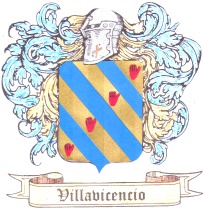Numerous documents with reference to the surname "Villavicencio" can be found in the "Portal de Archivos Espanoles" of the Ministry of Culture of Spain located in Madrid. These documents are the earliest records known to exist about the first "Villavicencio" in the Philippines.
There are two Spanish documents both entitled "Orden de pagar lo que se le debe a Diego de Villavicencio" (English Translation is “Order to pay what is owed to Diego de Villavicencio”) which were written on Aug 21, 1623 and Oct 11, 1634, respectively in Madrid.
The two documents were Royal Decrees addressed to the officials of the Royal Treasurer of Mexico which ordered them to pay the salary of a certain “Diego de Villavicencio” for his services as pilot of the ship in a trip he made to the Philippines in 1613. Diego was ordered to relieve General Arnada Ruy Gonzalez Sequeira who had in his command 5 caravelles or ships.
The catalog numbers and Reference Codes of these documents are:
No.12492 ES.41091.AGI/16403.14.343//Philippines,340,L.3,F.343R-345R
No.15634 ES.41091.AGI/16403.14.343//Philippines,340,L,3,F.481R-482R
Another document dated Aug 9, 1633 states that the first settlers of the Philippines included: Juan de Salazar and Maria Bermudez de Villavicencio.
Reference Code: ES.41091.AGI/16403.14.42//Philippines,41,n.26.
Several documents mentioned the name of a "Captain Diego de Hinojosa Villavicencio". He left the Philippines and went to Spain via a ship from Denmark on November 18, 1648. He was assigned to report on the status of the Philippines regarding the Dutch attacks, earthquakes, lack of ships from New Spain, etc. He also reported on the abuses of a Manuel Estacio Venegas, a Sergeant Major in Manila.
Reference Code: ES.41091.AGI/16403.14.44//Philippines,43,No.8
Another document mentioned a Captain Pedro de Vera Villavicencio. He moved to China from the Philippines together with a Dominican priest, Friar Victorio Riccio who founded a church in Hyamuang sometime in 1656.
Juan de Villavicencio served in acting capacity as "Castellano de Santiago de Manila" until June 4, 1675. He took the position vacated by Lorenzo de Orellana y Ugalde on account of his death.
Antonio Nunez de Villavicencio worked for the Royal Treasury of the Philippines in 1730. A certain Jose Antonio Nunez de Villavicencio was documented to have died on July 12, 1742. I believe that Jose Antonio and Antonio is one and the same person. Certain documents also referred to him as Jose Villavicencio .
The documents from the archives seems to indicate that the original "Villavicencio" originated from New Spain and was able to reach the Philippines through the Galleon Trade which started in 1565. The Manila-Acapulco galleons were trading ships that sailed once or twice a year between Acapulco, New Spain and Manila, Philippines. New Spain was the viceroyalty of the Spanish colonial empire with its capital in Mexico City. The Philippines was included in the Spanish East Indies and a part of New Spain.
The "Portal de Archivos Espanoles" is originally written in Spanish. The information stated above is my English translation of the related documents.
There are more names pertaining to "Villavicencio" in the Philippines in the archives. It will take some time and effort to go through the numerous documents and translate them.
It was my belief that Villavicencios were all originally from Taal, Batangas in the Philippines. I discovered on FamilySearch.org that there existed persons with the Villavicencio surname in Nueva Ecija, Bacolod, Malolos, San Rafael Bulacan, Cavite City, Iloilo, Marinduque, Negros, Tondo, Malabon, etc. aside from those who were originally domiciled in Taal and it's neighboring towns of Calaca and Lemery. The names existed as early as the 18th century.
Here is a link to Villavicencio in the Philippines during 18th century
For comments, email vee1628@yahoo.com.
Note on FamilySearch.org:
FamilySearch.org belongs to the Church of the Latter Day Saints or the Mormon Church. They have started to digitize baptismal, birth, death and marriage records of the inhabitants of the Philippines based on church and civil records dating back to 1642 until 1994. Most of the original records were written in transcript and the data that was entered into their database was based on the interpretation of the data entry personnel. Names and surnames were misspelled as entered into the database causing redundancy in the data and false identity. One would appreciate the value of utilizing their database rather than having to travel to the different towns and cities around the country in order to gather these data from the individual municipal offices and parish churches.




